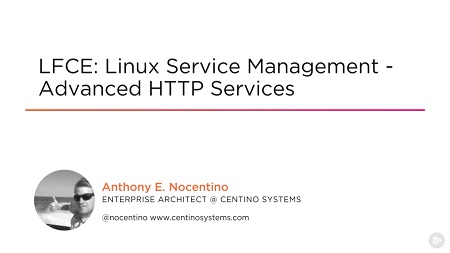
English | MP4 | AVC 1280×720 | AAC 44KHz 2ch | 2h 27m | 284 MB
Looking to boost performance and add functionality to your production web site? In this course, you’ll look at techniques such as proxying and caching using Squid Proxy Server and Apache Modules to help you reach those goals.
More and more it is becoming essential to boost the performance and functionality of your production web site to meet the needs of clients. In this course, LFCE: Linux Service Management – Advanced HTTP Services you’ll take your LINUX sysadmin skills to the next level and get started on your LFSA/RHCSA and LFCE/RHCE path. First, this course dives deep into HTTP services so you can provide high performance HTTP based services at scale. Next, you’ll start off on the client side and look at providing security and performance using Squid proxy server. Finally, you’ll switch to the server side and look at httpd modules, configuring proxying, and caching for httpd services. By the end of this course, you will be prepared to boost the performance and functionality of your web site through important Linux skills.
Table of Contents
Course Overview
1 Course Overview
Introduction and Lab Setup
2 Introduction, Course, and Module Overview
3 The Linux Foundation, LFCE, and RHCE Certifications
4 Introducing Our Lab Environment
5 Demo – Lab Network Configuration Review
6 Module Summary and What’s Next!
Building Scalable Internet Architectures
7 Introduction, Course, and Module Overview
8 Find the Bottleneck and Components of a Web Site
9 Client Side HTTP Proxy and Planning Web Server Hardware
10 Managing Web Server Resources and Tuning
11 Demo – Performance Tuning Basics – MPM and Modules
12 Accessing HTTP Resources and Content Caching
13 SSL Offloading, HTTP Compression, and System Monitoring
14 Demo – Enabling and Measuring the Impact of HTTP Compression
15 Bringing the Pieces Together, Module Summary, and What’s Next!
Installing and Configuring Squid Proxy Server
16 Introduction, Course, and Module Overview
17 HTTP Proxy Concepts
18 Installing and Configuring Squid and Squid Log Files
19 Reading Log Records & Demo-Installing & Configuring Squid, Configuring a Proxy Client, & Reading access.log files
20 Access Controls and Restricting Access to Internet Resources
21 Demo – Reviewing squid.conf and Restricting Access to Internet Resources – Part 1
22 Demo – Reviewing squid.conf and Restricting Access to Internet Resources – Part 2
23 Demo – Reviewing squid.conf and Restricting Access to Internet Resources – Part 3
24 Adding a Disk Based Cache Directory
25 Demo – Adding a Cache Directory, Moving Your Cache to Another Directory
26 Transparent Proxy
27 Demo – Configuring a Transparent Proxy
28 Module Overview and What’s Next!
Configuring Advanced HTTP Services – Apache Modules
29 Introduction, Course, and Module Overview
30 Introducing and Using Modules
31 Commonly Used Modules
32 Demo – Modules – Configuration Overview
33 Demo – Modules – Default Modules and Adding a New Module
34 Demo – Modules – Configuring a Module – mod_alias
35 CGI Applications
36 Demo – Configuring a CGI Application
37 Module Summary and What’s Next!
Configuring Proxying and Caching for HTTP Services
38 Introduction, Course, and Module Overview
39 Proxying and Caching Concepts and Anatomy of a Reverse Proxied Request
40 Configuring Squid as a Reverse Proxy
41 Demo – Configuring Squid as a Reverse Proxy
42 Choosing a Caching Engine
43 Module Summary and Thank You!
Resolve the captcha to access the links!